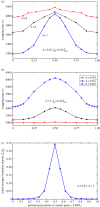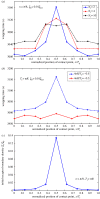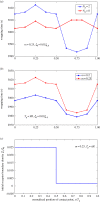Effects of ligand distribution on receptor-diffusion-mediated cellular uptake of nanoparticles
- PMID: 28573012
- PMCID: PMC5451813
- DOI: 10.1098/rsos.170063
Effects of ligand distribution on receptor-diffusion-mediated cellular uptake of nanoparticles
Abstract
Biophysical-factor-dependent cellular uptake of nanoparticles (NPs) through receptor-diffusion-mediated endocytosis bears significance in pathology, cellular immunity and drug-delivery systems. Advanced nanotechnology of NP synthesis provides methods for modifying NP surface with different ligand distributions. However, no report discusses effects of ligand distribution on NP surface on receptor-diffusion-mediated cellular uptake. In this article, we used a statistical dynamics model of receptor-diffusion-mediated endocytosis to examine ligand-distribution-dependent cellular uptake dynamics by considering that ligand-receptor complexes drive engulfing to overcome resistance to membrane deformation and changes in configuration entropy of receptors. Results showed that cellular internalization of NPs strongly depended on ligand distribution and that cellular-uptake efficiency of NPs was high when ligand distribution was within a range around uniform distribution. This feature of endocytosis ensures robust infection ability of viruses to enter host cells. Interestingly, results also indicated that optimal ligand distribution associated with highest cellular-uptake efficiency slightly depends on distribution pattern of ligands and density of receptors, and the optimal distribution becomes uniform when receptor density is sufficiently large. Position of initial contact point is also a factor affecting dynamic wrapping. This study explains why most enveloped viruses present almost homogeneous ligand distribution and is useful in designing controlled-release drug-delivery systems.
Keywords: cellular uptake; controlled-release drug delivery; optimal ligand distribution; receptor diffusion.
Conflict of interest statement
The authors declare no competing interests.
Figures












Similar articles
-
Role of Ligand Distribution in the Cytoskeleton-Associated Endocytosis of Ellipsoidal Nanoparticles.Membranes (Basel). 2021 Dec 19;11(12):993. doi: 10.3390/membranes11120993. Membranes (Basel). 2021. PMID: 34940494 Free PMC article.
-
Understanding receptor-mediated endocytosis of elastic nanoparticles through coarse grained molecular dynamic simulation.Phys Chem Chem Phys. 2018 Jun 20;20(24):16372-16385. doi: 10.1039/c7cp08644j. Phys Chem Chem Phys. 2018. PMID: 29445792
-
Influence of ligand distribution on uptake efficiency.Soft Matter. 2015 Apr 14;11(14):2726-30. doi: 10.1039/c4sm02815e. Soft Matter. 2015. PMID: 25683904
-
Cellular interactions of therapeutically delivered nanoparticles.Expert Opin Drug Deliv. 2011 Feb;8(2):141-51. doi: 10.1517/17425247.2011.547934. Epub 2011 Jan 11. Expert Opin Drug Deliv. 2011. PMID: 21219249 Review.
-
Intracellular uptake, transport, and processing of gold nanostructures.Mol Membr Biol. 2010 Oct;27(7):299-311. doi: 10.3109/09687688.2010.507787. Epub 2010 Oct 7. Mol Membr Biol. 2010. PMID: 20929337 Review.
Cited by
-
Polymeric Nanoparticles Properties and Brain Delivery.Pharmaceutics. 2021 Nov 30;13(12):2045. doi: 10.3390/pharmaceutics13122045. Pharmaceutics. 2021. PMID: 34959326 Free PMC article. Review.
-
Effect of Physico-Chemical Properties of Nanoparticles on Their Intracellular Uptake.Int J Mol Sci. 2020 Oct 28;21(21):8019. doi: 10.3390/ijms21218019. Int J Mol Sci. 2020. PMID: 33126533 Free PMC article. Review.
-
l-Type amino acid transporter 1-targeting nanoparticles for antisense oligonucleotide delivery to the CNS.Mol Ther Nucleic Acids. 2024 Sep 16;35(4):102340. doi: 10.1016/j.omtn.2024.102340. eCollection 2024 Dec 10. Mol Ther Nucleic Acids. 2024. PMID: 39411247 Free PMC article.
-
Role of Ligand Distribution in the Cytoskeleton-Associated Endocytosis of Ellipsoidal Nanoparticles.Membranes (Basel). 2021 Dec 19;11(12):993. doi: 10.3390/membranes11120993. Membranes (Basel). 2021. PMID: 34940494 Free PMC article.
-
Virus-Shaped Mesoporous Silica Nanostars to Improve the Transport of Drugs across the Blood-Brain Barrier.ACS Appl Mater Interfaces. 2024 Jul 24;16(29):37623-37640. doi: 10.1021/acsami.4c06726. Epub 2024 Jul 10. ACS Appl Mater Interfaces. 2024. PMID: 38988046 Free PMC article.
References
-
- Hillaireau H, Couvreur P. 2009. Nanocarriers' entry into the cell: relevance to drug delivery. Cell. Mol. Life Sci. 66, 2873–2896. (doi:10.1007/s00018-009-0053-z) - DOI - PMC - PubMed
-
- Reynwar BJ, Illya G, Harmandaris VA, Müller MM, Kremer K, Deserno M. 2007. Aggregation and vesiculation of membrane proteins by curvature-mediated interactions. Nature 447, 461–464. (doi:10.1038/nature05840) - DOI - PubMed
-
- Nel AE, Mädler L, Velegol D, Xia T, Hoek EMV, Somasundaran P, Klaessig F, Castranova V, Thompson M. 2009. Understanding biophysicochemical interactions at the nano-bio interface. Nat. Mater. 8, 543–557. (doi:10.1038/nmat2442) - DOI - PubMed
-
- Poland CA, et al. 2008. Carbon nanotubes introduced into the abdominal cavity of mice show asbestos-like pathogenicity in a pilot study. Nat. Nanotechnol. 3, 423–428. (doi:10.1038/nnano.2008.111) - DOI - PubMed
-
- Sahay G, Alakhova DY, Kabanov AV. 2010. Endocytosis of nanomedicines. J. Control. Release 145, 182–195. (doi:10.1016/j.jconrel.2010.01.036) - DOI - PMC - PubMed
LinkOut - more resources
Full Text Sources
Other Literature Sources
Miscellaneous

